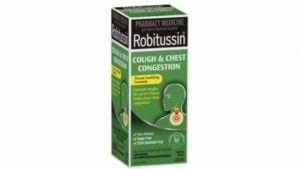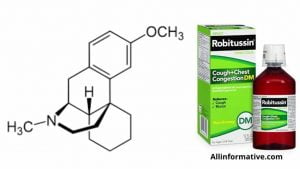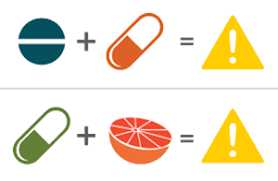Robitussin is use to treat coughs and congestion cause by common cold, bronchitis and breathing illnesses. Robitussin is an “Expectorant”. It works by thinning and loosening mucus in airways, clearing congestion and making breathing easier. In this page we discuss about Robitussin | Cough Syrup Uses, Side Effects and Interactions.
Contents
Robitussin:
Robitussin has another name “Guaifenesin”. Guaifenesin is use to treat coughs and congestion cause by common cold, bronchitis and other breathing illnesses. This product is usually not use for ongoing cough from smoking or long term breathing problems. Such as chronic bronchitis and emphysema. The Guaifenesin is an expectorant. It works by thinning and loosening mucus in airways, clearing congestion and making breathing easier.
If you are self treating with this medication, it is important to read package instructions carefully. Before you start using this product to be sure it is right for you. Cough and cold products have not been show to be safe or effective in children younger than 6 years. Therefore, do not use this product to treat cold symptoms in children younger than 6 years unless specifically direct by doctor.
Some products such as long acting tablets or capsules not recommended for use in children younger than 12 years. Ask your doctor or pharmacist for more details about using your product safely. These products do not cure or shorten length of common cold. To decrease risk for side effects, carefully follow all dosage directions. Do not give other cough and cold medication that might contain same or similar ingredients.
Ask doctor or pharmacist about other ways to relieve cough and cold symptoms. Such as drinking enough fluids, using humidifier and saline nose drops or spray. These products do not cure or shorten length of common cold and may cause serious. . Dextromethorphan belong to class of drugs known as cough suppressants. It acts on part of brain to reduce urge to cough.
Dosage:
The dose of this medicine will be different for different patients. Follow your doctor’s orders or directions on label. The following information includes only average doses of this medicine. If your dose is different, do not change it unless your doctor tells you to do so.
The amount of medicine that you take depends on strength of medicine. Also, number of doses you take each day, time allow between doses and length of time you take medicine depend on medical problem for which you are using the medicine.
For lozenge dosage form:
| AGE | DOSAGE | TIME |
| Adults 12 years | 5 to 15 mg | 2-4 hours |
| 6 to 12 years | 5 to 15 mg | 2-6 hours |
| 4 to 6 years | 5 mg | 2-4 hours |
| Up to 4 years | Do not use it. | Do not use it. |
For syrup dosage form:
| AGE | DOSAGE | TIME |
| Adults 12 years | 30 mg | 6-8 hours |
| 6 to 12 years | 7 mg | 6-8 hours |
| 4 to 6 years | 3.5 mg | 6-8 hours |
| Up to 4 years | Do not use it. | Do not use it. |
For extended release oral suspension dosage form :
| AGE | DOSAGE | TIME |
| Adults 12 years | 60 mg | 12 hours |
| 6 to 12 years | 30 mg | 12 hours |
| 4 to 6 years | 15 mg | 12 hours |
| Up to 4 years | Do not use it. | Do not use it. |
For Robitussin Gel form :
Liquid-Fast relief that controls coughs for up to eight hours in convenient and portable Liquid Gels format. This non drowsy formula contains no alcohol or sucrose.
| AGE | DOSAGE | TIME |
| Adults 12 years | 2 Cough Gels | 24 hours |
| under 12 years | Do not use it. | Do not use it. |
Take every 6-8 hours or as directed by doctor. Maximum 4 times per day.
Make certain your health care professional knows if you are on low sodium, low sugar or other special diet. Most medicines contain more than their active ingredient and many liquid medicines contain alcohol.
Use this medicine only as directed by your doctor or the directions on label. Do not use more of it. Do not use it more often and not use it for longer time than your doctor or label says. Although this effect has happened only rarely. Dextromethorphan has become habit forming in some persons who use too much for long time.
NON-MEDICINAL INGREDIENTS:
Alcohol, citric acid, D&C Red No. 33, FD&C Red No. 40, flavour, glycerin, invert sugar, maltol, sodium benzoate and water.
How to use Robitussin Liquid?
Take this medication by mouth with or without food as directed by your doctor usually every 4 hours. If you are self treating, follow all directions on product package. If you have any questions ask your doctor or pharmacist.
Guaifenesin may have bitter taste. Do not split tablets unless they have score line and your doctor or pharmacist tells you to do so. Swallow whole or split tablet without crushing or chewing. If you are using liquid form of this medication, carefully measure dose using special measuring device or spoon. Do not use household spoon because you may not get correct dose.
For powder packets, empty entire contents of packet onto tongue and swallow. To prevent bitter taste, do not chew. Dosage is base on your age, medical condition and response to treatment. Do not take more than 6 doses in day. Do not increase your dose or take this drug more often than directed.
Drink plenty of fluids while taking this medication. Fluids will help to break up mucus and clear congestion. Tell your doctor if your cough is accompany by fever, severe sore throat, rash, persistent headache, persists, returns or worsens after 7 days. These may be signs of serious medical problem. Seek immediate medical attention if you think you may have serious medical problem.
Robitussin History:
The racemic parent compound racemorphan was first describe in Swiss and US patent application from Hoffmann-La Roche in 1946 and 1947. Respectively a patent was grant in 1950. A resolution of two isomers of racemorphan with tartaric acid was publish in 1952. Dextromethorphan was successfully test in 1954 as part of US Navy and CIA-fund research on nonaddictive substitutes for codeine.
Dextromethorphan was approve by FDA in 1958 as an over counter antitussive. Its use as an antitussive is less beneficial nowadays. As had been initially hope, dextromethorphan was solution for some of problems associated with use of codeine phosphate as cough suppressant. Such as sedation and opiate dependence but like dissociative anesthetics phencyclidine and ketamine. Dextromethorphan later became associated with nonmedical use.
Dextromethorphan is prohibit for sale to minors in State of California and in State of Oregon as of January 1, 2018. Several other states have also began regulating sales of dextromethorphan to minors. As early as 1996, dextromethorphan hydrobromide powder could be purchase in bulk from online retailers. Allowing users to avoid consuming dextromethorphan in syrup preparations.
During 1960s and 1970s, dextromethorphan became available in an over counter tablet form by brand name Romilar. In 1973, Romilar was take off shelves after burst in sales because of frequent misuse. A few years later products with an unpleasant taste were introduce. But later same manufacturers began producing products with better taste. The advent of widespread internet access in 1990s allow users to rapidly disseminate information about dextromethorphan and online discussion groups form around use and acquisition of drug.
Side Effects:
Dizziness, drowsiness, nausea and vomiting may occur. Any of these effects persist or worsen notify your doctor or pharmacist promptly. If your doctor has direct you to use this medication, remember that he or she has judge that benefit to you is greater than risk of side effects. Many people using this medication do not have serious side effects.
A very serious allergic reaction to this drug is unlikely. But seek immediate medical attention if it occurs. Symptoms of serious allergic reaction may include: rash, itching, swelling, severe dizziness and trouble breathing. Less serious side effects may include:
- Dizziness
- Blurred vision
- Confusion
- Drowsiness
- Shakiness
- Nervousness
- Headache
- Restlessness
- Irritability
- Slowed breathing
- Constipation
- Unsteady walk
- Rash
- Nausea
- Vomiting
- Stomach upset
This is not complete list of possible side effects. If you notice other effects not list above contact your doctor or pharmacist. Call your doctor for medical advice about side effects. Liquid forms of this product may contain sugar and alcohol. Caution is advise if you have diabetes, liver disease or other condition that requires you toavoid these substances in your diet. The liquid forms and powder packets of this medication may contain aspartame.
Before taking this drug, tell your doctor or pharmacist if you are allergic to guaifenesin or dextromethorphan or if you have any other allergies. This product may contain inactive ingredients. That can cause allergic reactions or other problems. Talk to your pharmacist for more details.
Overuse Warning:
Robitussin DM, sometimes misuse to experience high known as “robo-tripping.” This misuse is very dangerous because it often leads to overdose. Dextromethorphan overdose can cause:
- confusion
- giddiness
- slow breathing
- nausea
- vomiting
- agitation
- nervousness
- restlessness
- unsteadiness
- dizziness
- vision changes
- shortness of breath
- fast heart rate
- hallucinations
- seizures
- coma
Robitussin DM may be drug to help ease your chest congestion and cough. However, some people may need adjust dosages or other remedies for their coughs.
For example, dextromethorphan can increase risk of drowsiness in older people. So, if you are an older adult, you may need to use lower dose of Robitussin DM. Talk to your pharmacist or doctor to find out an appropriate dose.
What other drugs could interact with this medication?
There may be an interaction between dextromethorphan and any of following:
- Abiraterone acetate
- Amiodarone
- Amphetamines
- Antipsychotics
- Asunaprevir
- Bromocriptine
- Bupropion
- Buspirone
- Celecoxib
- Chloroquine
- Cimetidine
- Cinacalcet
- Clobazam
- Cobicistat
- Cyclobenzaprine
- Darifenacin
- Delavirdine
- Diphenhydramine
- Dronedarone
- Ergot alkaloids
- HIV protease inhibitors
- Imatinib
- Isoniazid
- Ketoconazole
- Linezolid
- Lithium
- Memantine
- Meperidine
- Methadone
- Metoclopramide
- Mirabegron
- Mirtazapine
- Monoamine oxidase inhibitors
- Narcotic pain relievers
- Nilotinib
- Peginterferon alfa-2b
- Quinidine
- Quinine
- St. John’s wort
- Selective serotonin reuptake inhibitors
- Serotonin antagonists
- Serotonin/norepinephrine reuptake inhibitors
- Tapentadol
- Terbinafine
- Ticlopidine
- Tramadol
- Trazodone
- Tricyclic antidepressants
- “Triptan” migraine medications
- Tryptophan
Interactions:
Drug interactions may change how your medications work or increase your risk for serious side effects? This document does not contain all possible drug interactions. Keep list of all products you use including prescription or nonprescription drugs and herbal products. Share it with your doctor and pharmacist. Do not start, stop or change dosage of any medicines without your doctor’s approval.
Do not give any over counter cough and cold medicine to baby or child under 4 years of age. Using these medicines in very young children might cause serious or possibly life threatening side effects . This product is available in following dosage forms:
- Suspension
- Extended Release
- Solution
- Liquid
- Capsule
- Liquid Filled
- Elixir
- Gel
- Syrup
Taking certain MAO inhibitors with this medication may cause a serious drug interaction. Avoid taking isocarboxazid, methylene blue, moclobemide, phenelzine, procarbazine, rasagiline, safinamide, selegiline or tranylcypromine during treatment with this medication. Most MAO inhibitors should also not be take for two weeks before treatment with this medication. Ask your doctor when to start or stop taking this medication.
A product that may interact with this drug is rolapitant. Guaifenesin and dextromethorphan are available in both prescription and nonprescription products. Check labels of all your medications to make sure you are not taking more than one product. That containing guaifenesin or dextromethorphan.
Missed Dose:
If you miss dose of this medicine, take it as soon as possible. However, if it is almost time for your next dose, skip miss dose and go back to your regular dosing schedule.
Do not take double doses.
Storage:
Store the medicine in a closed container at room temperature, away from heat, moisture, and direct light. Keep from freezing.
Keep out of the reach of children. Do not keep outdated medicine or medicine no longer needed.
Precautions:
If your cough has not improve after 7 days. Also If sore throat has not improve after 2 days. If you have high fever, skin rash or continuing headache with cough. If asthma or high blood pressure is present check with your doctor. These signs may mean that you have other medical problems.
Dissolve lozenges in mouth with caution to lessen risk of choking.
Who should NOT take this medication?
Do not take Dextromethorphan if you:
- Are allergic to Dextromethorphan or to any of ingredients of medication.
- Taking MAO inhibitors or have taken them in previous 2 weeks.
- Have respiratory depression.
Do not give this medication to children less than 6 years old.
Conclusion:
Robitussin is an expectorant. It helps loosen congestion in your chest and throat. We making it easier to cough out through your mouth. It works by thinning and loosening mucus in airways, clearing congestion and making breathing easier. Robitussin is use to reduce chest congestion cause by common cold, infections or allergies. It may also be use for purposes not list in this medication guide.





